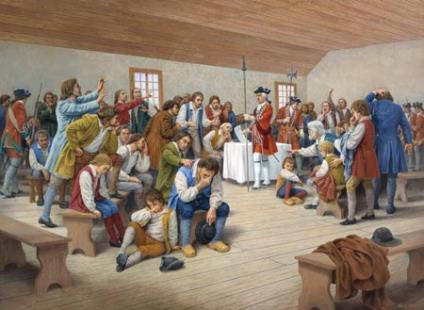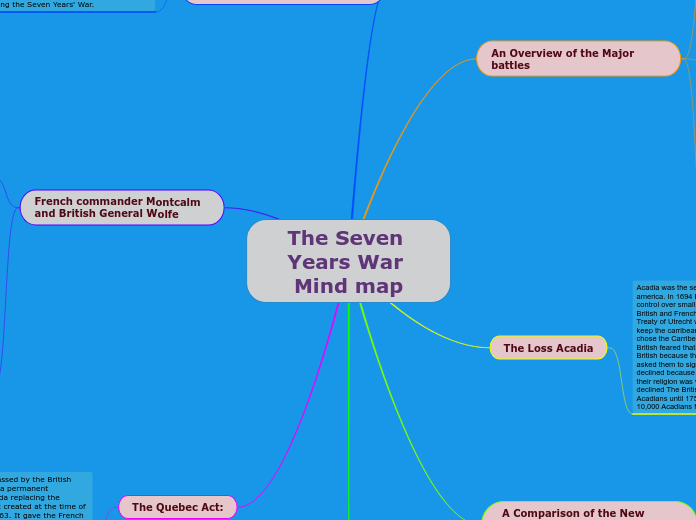The Seven Years War Mind map
An Overview of the Major battles
The Beauport Shore: The battle on Beauport Shore was caused by the british. The British general Wolfe, wanted the French commander Montcalm to come out and fight. So he sent a fleet to Beauport shore that consisted of 4000 soldiers. In the end the Wolfe’s army lost about 440 men in the battle and Britain lost in utter defeat.
The Siege of Louisbourg: The Louisbourg fortress was built by the French to keep away British attacks in New France. In 1758, there were 2 sieges brought on to Louisbourg. On the first siege it was by the British who soon later had to give it back because the peace treaty was signed. The 2nd siege was by General Wolfe and General Jeffery who brought naval warships, surrounded them, claimed the fortress and joined the British fleet.
The Plains of Abraham: The Plains of Abraham is France’s largest settlement. Britain knew if they could take over the Plains of Abraham they could win and end up defeating France. Wolfe Brought about 7,700 troops while Montcalm brought around 13,00 troops with some being first nations. The British fleet was stretching up to more than a mile of the Plains of Abraham with each soldier in a single file line with each of their muskets loaded. When the French got up to 40 meters away from the British, the British started to fire. During the 2nd volley of the Britains fire the French started to slowly retreat to Beauport. During the Battle Wolfe was wounded and died. The British sent their army to Quebec city and later Montcalm was killed. In September the French surrendered and this led to Britain's Victory.
The Loss Acadia
Acadia was the second colony in France of North america. In 1694 British attacked Acadia and took control over small parts of Acadia. After the war the British and French made a peace treaty called the Treaty of Utrecht where France had to choose to keep the carribean islands or the Acadias and they chose the Carribean Islands. In further time the British feared that the Acadians would betray the British because they were mainly French so they asked them to sign the oath of allegiance. They declined because they were French Catholics and their religion was very important to them. Since they declined The British sent Soldiers to Harass the Acadians until 1755 to 1760 they expelled up to 10,000 Acadians from their land.
A Comparison of the New France colonies and the British Colonies before the war
The French and British were both trying to create a colony in North America as fast as possible. Both countries were trying to make more colonies to expand the land/territory. The French had a very good trade relationship with the First nations. They traded goods like wool, iron tools and hats from France to help the First Nations and the First nations gave furs and also gave them items that they used to help the French.
The Thin Red Line
The Thin Red line:
The Thin Red Line was a military strategy invented in Canada during the Seven Years' War. Britain began to simonetainsly use this strategy. The Thin Red Line was a strategy with a line of soldiers in 3 rows with all their muskets loaded. When an army is about 70 meters apart from the first row, the first row of soldiers shoot, then when they reload they kneel, Then the second rows fire etc. When Wolfe used this strategy on the Plains of Abraham I found it interesting on how he determined a certain distance between France’s army on when is the right time to strike.
The Royal Proclamation of 1763
The Royal Proclamation of 1763 was established as the basis for governing the North American territories surrendered by France to Britain in the Treaty of Paris, following the Seven Years' War.
French commander Montcalm and British General Wolfe
Montcalm:
General Montcalm was a french commander and was known as the commander of the forces in North America during the Seven Years' War. During the Seven Years war Montcalm was heavily protected in mount marenzy falls. When A Scotsman told Montcalm that the British were at the plains of Abraham he ordered to gather his troops by mount marenzy falls at beauport and sent them to attack the British, Slowly the British made the French retreat. The next day the British attacked the French and killed Montcalm which finally made the French surrender to the British.
Wolfe:
General Wolfe was a British commander and is Britain's Hero. During the Seven Years war Wolfe Conquered Louisburg and then set his eyes on Quebec. He started to attack the back of Quebec because it wasn’t well defended. He wanted Montcalm to come out and fight but he didn’t come out. So Wolfe led his army to mount marenzy falls to attack, but he failed in this attempt. He didn’t want to give up so he travelled in small boats in the night and climbed the mountain where it was steep where the defence is weak. They then captured the french position that was at the top of the cliff. Then in the morning the British were preparing their attack on Quebec on the plains of Abraham. When the French sought their counterattack on the British Montcalm’s soldiers slowly retreated, but Wolfe was brutally injured early in the battle and died.
The Quebec Act:
The Quebec act was passed by the British Parliament to institute a permanent administration in Canada replacing the temporary government created at the time of the Proclamation of 1763. It gave the French Canadians complete religious freedom and restored the French form of civil law.







